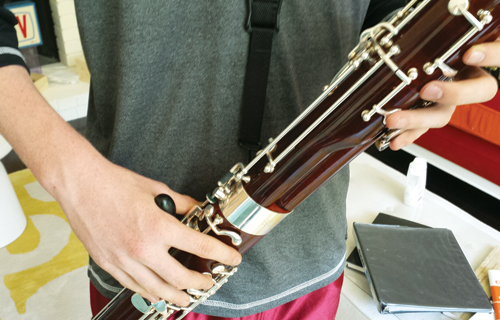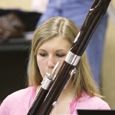
Because of its size, weight, and playing position, the bassoon can be difficult for a player to support while playing. The vast majority of bassoonists in North America learn to play the bassoon using a seat strap. Among other limitations, the big drawback with using a seat strap is that it prevents playing while standing. This article explores the available options for supporting the bassoon and compares the pros and cons of each.
The Bassoon’s Differences
Most woodwind instruments are supported by the player’s right thumb, either directly or with a thumb rest. For woodwinds of larger sizes, such as the English horn and larger saxophones, a neck strap may be used in addition to the thumb rest.
The bassoon requires a different approach. The instrument consists of two parallel bores, and it must be positioned in a different orientation from other woodwind instruments. When playing the bassoon, the player’s right thumb is not positioned beneath the instrument, and all ten fingers are needed to operate keys or tone holes. Therefore, an alternative method for supporting the instrument is necessary.
There are two possible ways to support the bassoon without using the fingers. The first way is to support the bassoon from above, hooking on to somewhere near the middle of the instrument. For this approach, a neck strap, shoulder strap, or harness can be used. The second way is to support the bassoon from below, near the boot end of the instrument. For this approach, possible options include the seat strap, spike, or stand.
For centuries, the most popular solution across the world has been to support the weight of the bassoon with the player’s neck, through the use of a neck strap (in England, this is known as a sling). The neck strap hooks on to a ring at the top end of the boot joint. Variations on this approach include the shoulder strap, which is worn diagonally across the body, and the harness.
The Seat Strap
In North America, however, most instructors teach bassoon students to play using a seat strap. This strap is secured on the seat by the player sitting on it, and a cup or hook connects the seat strap to the end cap of the boot joint of the instrument.
The idea behind using the seat strap is to alleviate the neck from having to support the weight of the bassoon. The bassoon has become heavier over the centuries, and many students find that it is physically tiring to hang the instrument from the neck. The seat strap allows students to avoid this burden.
However, the seat strap also has the big disadvantage of preventing the bassoonist from playing in a standing position. A bassoonist who depends on a seat strap will have to play everything, even solos, from a seated position. I find that it looks odd for a bassoonist to perform a solo or a concerto while sitting.
Another disadvantage to playing with a seat strap is a lack of flexibility and difficulty with making fine adjustments. Because the fulcrum is at the butt end of the instrument, far away from the center of the instrument, any fine adjustments made to the playing position may cause relatively large changes to the position of the reed. Fine adjustments to playing position are also difficult because the player has to become unseated to set the seat strap free and then sit down again after the adjustment is made (and this process may need to be repeated). As a result of these problems, the playing position and the angle of the reed can be compromised with students who rely on a seat strap. A further problem with using a seat strap is that it requires the left hand to support the weight of the instrument, and this sometimes leads to strain and injuries.
The Neck Strap
Unlike the seat strap, a neck strap will allow bassoon players to make fine adjustments to the playing position, since the fulcrum is close to the center of the instrument. The bassoonist can independently adjust the length of the neck strap as well as the angle of the instrument. These adjustments allow the reed to enter the embouchure in a more controlled way.
Neck straps also make it possible for bassoonists to perform while standing. Playing in a standing position allows for better breathing, which is why singers typically perform while standing.
Some players use a balance hanger so that the bassoon can be hung from the neck strap at a location closer to the center of gravity of the bassoon. Variations on the neck strap include the shoulder strap, which is worn diagonally across the player’s chest, and the harness, which is like a four-point safety belt. These variations help to alleviate strain on the neck from the weight of the bassoon, but they may place a bigger constraint on the chest. (These options also may not be favored by female players.)
Neck straps are also more comfortable now than they used to be. Long ago the only neck straps available were thin leather straps, which could be uncomfortable during prolonged playing. Now, wide leather neck straps, as well as saxophone-type neck straps with plenty of padding, are readily available.
Recommendation
In my opinion, every bassoonist should be able to play while standing. Therefore, I would advise that any bassoonist who primarily uses the seat strap while playing should also learn to use a neck strap (or shoulder strap or harness).






